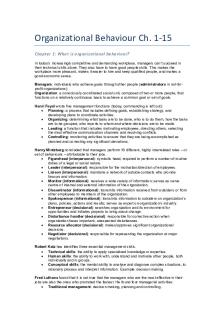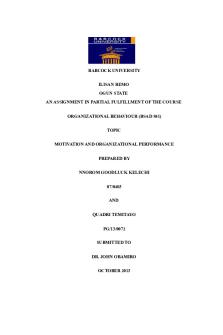Summary Organizational Behaviour Chapter 1-15 PDF

| Title | Summary Organizational Behaviour Chapter 1-15 |
|---|---|
| Author | Megan Schupp |
| Course | Organizational Behaviour |
| Institution | Erasmus Universiteit Rotterdam |
| Pages | 36 |
| File Size | 736.1 KB |
| File Type | |
| Total Downloads | 156 |
| Total Views | 724 |
Summary
Organizational Behaviour Ch. 1- 15Chapter 1 : What is or g anizatio nal be haviour?In today’s increasingly competitive and demanding workplace, managers can’t succeed in their technical skills alone. They also have to have good people skills. This makes the workplace more pleasant, makes it easier t...
Description
Organizational Behaviour Ch. 1-15 Chapter 1: What is organizational behaviour? In today’s increasingly competitive and demanding workplace, managers can’t succeed in their technical skills alone. They also have to have good people skills. This makes the workplace more pleasant, makes it easier to hire and keep qualified people, and makes a good economic sense. Managers: individuals who achieve goals through other people (administrators in not-forprofit organizations). Organization: a consciously coordinated social unit, composed of two or more people, that functions on a relatively continuous basis to achieve a common goal or set of goals. Henri Fayol wrote five management functions (today, commanding is left out): Planning: a process that includes defining goals, establishing strategy, and developing plans to coordinate activities. Organizing: determining what tasks are to be done, who is to do them, how the tasks are to be grouped, who reports to whom and where decisions are to be made. Leading: a function that includes motivating employees, directing others, selecting the most effective communication channels and resolving conflicts. Controlling: monitoring activities to ensure that they are being accomplished as planned and correcting any significant deviations. Henry Mintzberg concluded that managers perform 10 different, highly interrelated roles – or set of behaviours – attributable to their jobs. Figurehead (interpersonal): symbolic head, required to perform a number of routine duties of a legal or social nature. Leader (interpersonal): responsible for the motivation/direction of employees. Liaison (interpersonal): maintains a network of outside contacts who provide favours and information. Monitor (informational): receives a wide variety of information; serves as nerve centre of internal and external information of the organization. Disseminator (informational): transmits information received from outsiders or from other employees to members of the organization. Spokesperson (informational): transmits information to outsiders on organization’s plans, policies, actions and results; serves as expert on organization’s industry. Entrepreneur (decisional): searches organization and its environment for opportunities and initiates projects to bring about change. Disturbance handler (decisional): responsible for corrective action when organization faces important, unexpected disturbances. Resource allocator (decisional): makes/approves significant organizational decisions. Negotiator (decisional): responsible for representing the organization at major negotiations. Robert Katz has identifies three essential management skills. Technical skills: the ability to apply specialised knowledge or expertise. Human skills: the ability to work with, understand and motivate other people, both individually and in groups. Conceptual skills: the mental ability to analyse and diagnose complex situations, to rationally process and interpret information. Example: decision making. Fred Luthans found that it is not true that the managers who are the most effective in their jobs are also the ones who promoted the fastest. He found four managerial activities: Traditional management: decision making, planning and controlling.
Communication: exchanging routine information and processing paperwork. Human resource management: motivating, disciplining, managing conflict, staffing and training. Networking: socialising, politicking and interacting with outsiders. He found that among successful managers, networking made the largest relative contribution to success, and HRM made the least. Among effective managers, communication made the largest relative contribution to success, and networking the least.
Organizational behaviour: a field of study that investigates the impact that individuals, groups and structure have on behaviour within organizations, for the purpose of applying such knowledge toward improving an organization’s effectiveness. Systematic study: looking at relationships, attempting to attribute causes and effects and drawing conclusions based on scientific evidence. An approach that complements systematic study is evidence-based management (EBM): basing managerial decisions on the best available scientific evidence (managers should do the same as doctors). Intuition: a gut feeling not necessarily supported by research. The trick is to know when to go with your instincts. Use evidence as much as possible to inform your intuition and experience. OB is an applied behavioural science that is built on contributions from a number of behavioural disciplines. The predominant areas are: Psychology: the science that seeks to measure, explain, and sometimes change the behaviour of humans and other animals. Social psychology: an area of psychology that blends concepts from psychology and sociology and that focuses on the influence of people on one another. Sociology: the study of people in relation to their social environment or culture. Anthropology: the study of societies to learn about human beings and their activities. Human beings are complex and behave differently in every situation. Contingency variables: situational factors: variables that moderate the relationship between two or more other variables (x leads to y only under the conditions specified in z). OB offers solutions for today’s dynamic environment: 1. Responding to globalisation (people from different countries): Increased foreign assignments: a workforce with different needs, aspirations and attitudes. Working with people from different cultures: different motivation factors, communication. Coping with anticapitalism backlash: like Finland (a left country). Overseeing movement of jobs to countries with low-cost labour: balance interest and responsibilities. 2. Managing workforce diversity: the concept that organizations are becoming more heterogeneous in terms of gender, age, race, ethnicity, sexual orientation and inclusion of other diverse groups (people within given countries): Embracing diversity: melting pot replaced by recognizing and valuing differences. Changing European demographics: age and gender. Implications: shift from treating everyone alike to recognizing differences. It can increase creativity and innovation, and improve decision-making. 3. Increased demand capacity added excess supply increased competition: reduce costs, and improve productivity and quality. Tom Peters claimed almost all quality improvement comes via simplification of design, manufacturing, layout, processes and procedures. To achieve these ends, managers are implementing programmes like quality management and process reengineering (require extensive employee involvement). 4. Improving customer service. 5. Improving people skills.
6. Stimulating innovation and change: the challenge for managers is to stimulate their employee’s creativity and tolerance for change. 7. Coping with ‘temporariness’: because of change: globalisation, expanded capacity, and advances in technology. 8. Working in networked organisations: managers need to develop new skills (online). 9. Helping employees balance work-life conflicts. A number of forces have contributed to blurring the lines between employees’ work life and personal life: The creation of global organizations means their world never sleeps. Communication technology allows employees to do their work at home, or anywhere. Organisations are asking employees to put in longer hours. Fewer families have only a single breadwinner. 10. Creating a positive work environment. Positive organizational scholarship (or behaviour): an area of OB research that concerns how organizations develop human strength, foster vitality and resilience, and unlock potential. What’s good about organizations? 11. Improving ethical behaviour. Ethical dilemmas: situations in which individuals are required to define right and wrong conduct. Should they ‘blow the whistle’ if they uncover illegal activities? Should they follow orders with which they don’t agree? Etc. Model: an abstraction of reality; a simplified representation of some real-world phenomenon. Three levels of analysis in OB, whereby each level is constructed on the previous level: individual level group level organization systems level. Dependent variable: a response that is affected by an independent variable. In OB: Productivity: a performance measure that includes effectiveness (achievement of goals) and efficiency (the ratio between effective output to the input required to achieve). Absenteeism: the failure to report to work. Turnover: voluntary and involuntary permanent withdrawal from an organization, which causes increased recruiting/selection/training costs. Deviant workplace behaviour (antisocial behaviour or workplace incivility): voluntary behaviour that violates significant organizational norms and, in so doing, threatens the well being of the organization or its members. Absenteeism and turnover are indicators. It’s a response to dissatisfaction. Organizational citizenship behaviour (OBC): discretionary behaviour that is not part of an employee’s formal job requirements, but that nevertheless promotes the effective functioning of the organization. Job satisfaction: a positive feeling about one’s job resulting from an evaluation of its characteristics. It is an attitude rather than a behaviour. It still is a dependent variable. Independent variable: the presumed cause of some change in a dependent variable. Individual-level variables: people enter organizations with certain intact characteristics that will influence their behaviour at work (age, gender, values, attitudes, ability). There is little management can do to alter them. Group-level variables: not only the sum of individuals, but more complex. People behave differently in groups than when they are alone. Organization system-level variables: add formal structure to previous knowledge of individual and group behaviour. The organization’s internal culture; and the organization’s human resource policies and practices.
Chapter 2: Foundations of individual behaviour From management’s standpoint, the issue is knowing how rather than whether people differ in abilities and using this to increase the likelihood that an employee will perform their job well. Ability: an individual’s capacity to perform the various tasks in a job. Intellectual abilities: the capacity to do mental activities – thinking, reasoning, and problem solving. o Number aptitude: speedy/accurate arithmetic o Verbal comprehension: understand what is read/heard o Perceptual speed: quickly/accurately identify visual differences/similarities
Inductive reasoning: identify logical sequence in a problem and solve it Deductive reasoning: use logic and assess implications of an argument Spatial visualisation: imagine how an object looks like if changed in position Memory: retain and recall past experiences The above intelligence dimensions have positive correlations but aren’t perfect: people differ in their abilities. But they are high enough that there is a general/overall factor of intelligence: general mental ability (GMA). (It still recognizes the differences/specific abilities!) There has been a significant rise in the use of testing intelligence. The correlation between intelligence and job satisfaction is 0 because smart people have it better, but also expect more. Physical abilities: the capacity to do tasks that demand stamina, dexterity, strength, and similar characteristics. o Strength factors: Dynamic strength: exert muscular force repeatedly/continuously Trunk strength: exert muscular force using trunk muscles Static strength: exert force against external objects Explosive strength: expend a maximum of energy in explosive acts o Flexibility factors: Extent flexibility: move trunk/back muscles as far as possible Dynamic flexibility: make rapid, repeated flexing movements o Other factors: Body coordination: coordinate simultaneous actions of different parts of the body Balance: maintain equilibrium Stamina: continue maximum effort requiring prolonged effort o There is little relationships among the above mentioned. o Managers must ascertain the extent to which a job requires each of these and then assure that employees have them, in order to get high performance. o o o o
Many of the dependent variables (Ch. 1) are hard to assess. What can be easily assessed are the biographical characteristics: personal characteristics – such as age, gender, race, and length of tenure – that are objective and easily obtained from personnel records. Age. Important because (1) people believe that job performance declines with increasing age and (2) the workforce is ageing. But this is proven: (1) the older you get, the less likely you are to quit, (2) have lower rates of avoidable absence but higher rates of unavoidable absence, (3) the older, the more productive OR stable, and (4) among professionals, job satisfaction and age have a positive relationship. Gender. There is no significant difference in job productivity. Differences are: (1) Women prefer part-time work, flexible work schedules and telecommuting; (2) Women show more absenteeism because of e.g. a child that is ill. Race: the biological heritage people use to identify themselves. Minorities are sometimes discriminated against in job interviews, and between colleagues underrepresentation in management less pay. Employment tenure: length of time spent with the same employer. It is a good predictor of employee productivity since there is a positive relationship between seniority and job productivity. It is good in explaining absence (negative), turnover (negative), future behaviour, and job satisfaction (positive). Religion. This has always been a great battle. Learning: a relatively permanent (ingrained) change in behaviour that occurs as a result of experience. There are 3 theories that explain the process by which we acquire patterns of behaviour: Classical conditioning: a type of conditioning in which an individual responds to some stimulus that would not ordinarily produce such as response. It’s voluntary rather than reflexive. It is passive. o Unconditioned stimulus: something that invariably causes you to react in a specific way (e.g. meat for dogs) o Unconditioned response: the reaction on the unconditioned stimulus
Conditioned stimulus: artificial, it was originally neutral, but was paired with the unconditioned stimulus (e.g. meat), and eventually produced a response when presented alone (e.g. bell) o Conditioned response: the reaction on the conditioned stimulus, e.g. salivation because of the bell alone Operant conditioning: a type of conditioning in which desired voluntary behaviour leads to a reward or prevents a punishment. Behaviour is a function of its consequences. o Part of Skinner’s broader concept of behaviourism: a theory which argues that behaviour follows stimuli in a relatively unthinking manner (unawareness) Social-learning theory: the view that people can learn through observation and direct experience. You watch models. It is an extension of operating conditioning: it assumes that behaviour is a function of consequences AND it acknowledges the existence of observational learning and the importance of perception in learning. There are four processes to determine the influence of a model on an individual: o Attentional processes: recognizing and paying attention o Retention processes: how well remembered o Motor reproduction processes: perform the modelled activities o Reinforcement processes: positive incentives / rewards increase motivation o
Shaping behaviour: systematically reinforcing each successive step that moves and individual closer to the desires response. There are four ways to shape behaviour: Positive reinforcement: following a response with something pleasant, e.g. praising. Negative reinforcement: following a response by the termination or withdrawal of something unpleasant, e.g. looking through notes so the teacher won’t call you. Punishment: causing an unpleasant condition in an attempt to eliminate an undesirable behaviour, e.g. suspension. Extinction: eliminating any reinforcement that is marinating a behaviour, e.g. ignoring raised hands for questions in order to extinct them. Reinforcement is more effective than punishment because punishment is temporary and can have unpleasant side effects. Also, the recipient becomes resentful of the punisher. Reinforcement schedules: Continuous reinforcement: reinforces the desired behaviour each time it is demonstrated. Fast learning of new behaviour but rapid extinction Intermittent reinforcement: not each instance of a desirable behaviour is reinforced, but reinforcement is given often enough to make the behaviour worth repeating. o Ratio schedules: depend on how many responses the subject makes Fixed-ratio schedule: initiating rewards after a fixed or constant number of responses. Example: piece-rate pay. High and stable performance attained quickly but with rapid extinction Variable-ratio schedule: varying the rewards relative to the behaviour of the individual. Example: commissioned sales. Very high performance with slow extinction o Interval schedules: depend on how much time has passed since the previous reinforcement Fixed-interval schedule: spacing rewards at uniform time intervals Example: salaries. Average and irregular performance with rapid extinction Variable-interval schedule: distributing rewards in time so that reinforcements are unpredictable. Example: not announcing when a quiz will take place. Moderately high and stable performance with slow extinction OB Mod: the application of reinforcement concepts to individuals in the work setting. It follows a five-step problem-solving model: (1) identify critical behaviours; (2) develop baseline data (how many time does it occur); (3) identify behavioural consequences; (4) develop and implement an intervention strategy; and (5) evaluate performance improvement.
One problem with behaviourism is that thoughts and feelings immediately follow environmental stimuli, even those explicitly meant to shape behaviour. People weigh the value of these stimuli. This is contrary to the assumptions of behaviourism and OB Mod, which assume that people’s innermost thoughts and feelings in response to the environment are irrelevant. Operant conditioning and behaviourism have been superseded by other approaches that emphasise cognitive processes. Global implications: The structures and measures of intellectual abilities generalise across cultures. Biographical characteristics vary across cultures, but it is not known whether the relationships described above vary or generalise across cultures. It is not known whether the theories of learning generalise across cultures.
Chapter 3: Attitudes and job satisfaction Attitudes: evaluative statements or judgments concerning objects, people or events. They reflect how we feel about something. They have three components: Cognitive component: the opinion or belief segment of an attitude. It’s a description. Example: My pay is low. Affective component: the emotional or feeling segment of an attitude. Example: I am angry over how little I’m paid. Behavioral component: an intention to behave in a certain way toward someone or something. Example: I’m going to look for another job that pays better. These components are closely related and in reality they are very difficult to separate. It is always believed that attitudes cause behavior, but attitudes can also follow behavior. Cognitive dissonance: any incompatibility between two or more attitudes or between behavior and attitudes. Festinger argued that any form of inconsistency is uncomfortable and that individuals will attempt to reduce the dissonance and, hence, the discomfort. This is done by altering either the attitudes or the behavior or by developing a rationalization for the discrepancy. He proposed that the desire to reduce the dissonance depends on the importance of the elements creating it and the degree of influence the individual believes he ...
Similar Free PDFs

Chapter 2 ORGANIZATIONAL BEHAVIOUR
- 23 Pages
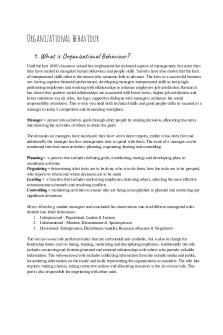
Organizational behaviour
- 67 Pages

Organizational Behaviour
- 2 Pages
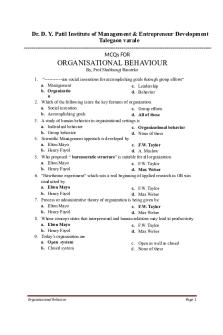
Organizational Behaviour mcqs
- 27 Pages
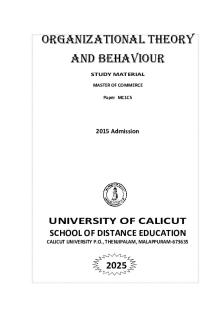
Organizational theory and behaviour
- 186 Pages
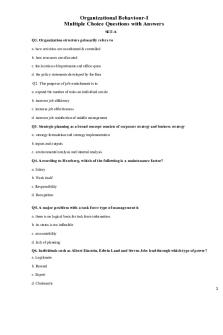
Organizational Behaviour MCQ SET
- 20 Pages
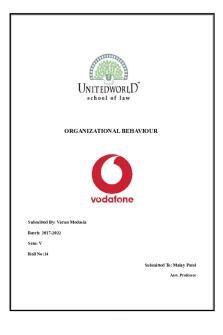
Organizational Behaviour Project
- 15 Pages
Popular Institutions
- Tinajero National High School - Annex
- Politeknik Caltex Riau
- Yokohama City University
- SGT University
- University of Al-Qadisiyah
- Divine Word College of Vigan
- Techniek College Rotterdam
- Universidade de Santiago
- Universiti Teknologi MARA Cawangan Johor Kampus Pasir Gudang
- Poltekkes Kemenkes Yogyakarta
- Baguio City National High School
- Colegio san marcos
- preparatoria uno
- Centro de Bachillerato Tecnológico Industrial y de Servicios No. 107
- Dalian Maritime University
- Quang Trung Secondary School
- Colegio Tecnológico en Informática
- Corporación Regional de Educación Superior
- Grupo CEDVA
- Dar Al Uloom University
- Centro de Estudios Preuniversitarios de la Universidad Nacional de Ingeniería
- 上智大学
- Aakash International School, Nuna Majara
- San Felipe Neri Catholic School
- Kang Chiao International School - New Taipei City
- Misamis Occidental National High School
- Institución Educativa Escuela Normal Juan Ladrilleros
- Kolehiyo ng Pantukan
- Batanes State College
- Instituto Continental
- Sekolah Menengah Kejuruan Kesehatan Kaltara (Tarakan)
- Colegio de La Inmaculada Concepcion - Cebu
